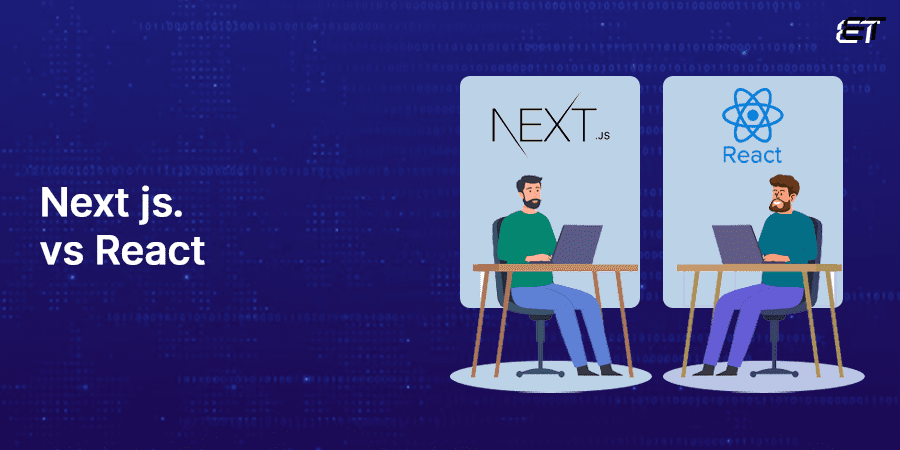
Nextjs vs React: Which Framework to Pick in 2026?
Nextjs vs React, let’s weigh some numbers, shall we?
As per a 2024 study, React is a favorite amongst JavaScript developers with 57% preferring to opt for the same. Meanwhile, Nextjs ranks at third at 27%.
This popularity can be attributed to the fact that React having been released three years before the latter, saw early mass adoption having been the first of the big frameworks in the market. With a solid track record of performance, constantly evolving with each version to meet the needs of developers, and a strong and active community, it reigns at the top.
However, Nextjs is not too far behind. With its latest update it has improved its ability to handle requests— 1062% more per second. Nextjs 13.5 also offered 22% faster local server startup through its App & Pages Router, 29% faster HMR i.e., faster iterations when saving changes, and 40% less memory usage as compared to its previous model.
So, how does one choose between the two frameworks?
In this blog, we answer just that! Read on as we delve into a detailed comparison of Nextjs vs React, outlining the pros and cons of each, their use cases, and more.
Need vetted React experts proficient in using React.js and React Native?
Introduction to React

Since its launch in 2013, React— the powerful JavaScript library developed by Facebook (now Meta)— is typically used for building user interfaces (UIs), especially for single-page applications.
Its ability to cut down on development time and costs by offering cross-platform flexibility makes it the go-to option for start-ups and established enterprises alike.
Meanwhile, for developers, its component-based structure helps create components that get used across different parts of an application and even projects, ensuring more maintainable codebases. These components also manage their own state which allows them to design complex UIs.
The framework also boasts a virtual DOM that boosts rendering by updating only the changed parts of the actual DOM.

Did you know Meta just released the latest version of the framework— React 19, this April? Check out its host of new features and improvements!
When to Use React?
1. Single Page Applications (SPAs)
Building SPAs, where the entire app loads on the first request and subsequent interactions take place dynamically without requiring a page refresh, is a great fit for the React framework. It allows for a seamless user experience. Applications such as Asana and Trello, where users interact with a complex interface, are prime examples
2. Apps with Interactive User Interfaces
React has a component-based architecture where components are capable of self-management. Hence, it is used for apps that demand responsive and engaging user experiences. For example, Facebook and Instagram use the framework for their interactive features such as likes, comments, and dynamic newsfeeds.
3. Cross-Platform Mobile Apps
Using a single codebase, React allows developers to create mobile apps for both iOS and Android. Given this cross-platform compatibility, it is highly preferred by brands wishing to expand to mobile devices without having to spend more time and money. Giants like Airbnb and UberEats for instance have leveraged the tool.
4. Progressive Web Apps (PWAs)
PWAs i.e., web apps that offer a native app-like experience within a browser by combining the best features of web and mobile applications, can be created with React. Its performance optimizations, offline features, and background data synchronization abilities prove advantageous for PWAs.

Unsure if adopting the React framework is the way to go? Here are some metrics to consider.
Introduction to Nextjs
Vercel’s Nextjs, launched in 2016, builds on the React framework but adds powerful features such as server-side rendering (SSR) and static site generation (SSG) to improve the performance of React applications.
The two capabilities foster faster load time and better SEO performance which has led to it being widely adopted by businesses that need a content-driven website.
On the other hand, for developers, Nextjs enables easier styling of components as it supports CSS and Sass out-of-the-box functionalities. Additionally, it allows them to build API endpoints within an app to simplify the development of serverless functions.
When to Use Nextjs?
1. For Content-Heavy and SEO-Driven Static Websites
Nextjs is well-suited for developing static sites, which are pre-rendered at build time. It comes with static site generation (SSG) support, which benefits content-heavy websites such as blogs, news and media publications, landing pages, and marketing pages, as they require fast-loading pages. In fact, Vercel itself uses the framework for its documentation.
Additionally, Nextjs is used by projects that require excellent SEO performance. With its integrated server-side rendering (SSR), search engines can receive fully-formed HTML, which improves indexing and search visibility. This makes it indispensable for any content-driven site where a substantial portion of users come from organic search traffic (Shopify, for example).
Not to forget, the framework comes with an incremental static regeneration feature that updates static pages incrementally as per data changes. It is hence the way to go for large e-commerce sites or news websites that need to frequently update content while also maintaining high performance.
2. Apps with Integrated Server-Side Logic Without Separate Backend
The framework facilitates backend development by enabling the creation of API routes within the same project. This makes Nextjs the preferred choice for apps looking to incorporate server-side logic without requiring a separate backend. It greatly simplifies workflows for projects requiring lightweight backend services such as form submission, authentication, and data fetching.
React vs Nextjs— now that we have understood the use cases of each, let’s learn how one fares to the other.
Nextjs vs React: A Detailed Comparison

The difference between Nextjs and React can be understood in terms of their distinct features, that serve different purposes. Let’s understand this better.
| Features | React | Nextjs |
| Nature | Uses a JavaScript library for developing user interfaces | Comes with more features to React framework |
| Rendering | Has default client-side rendering resulting in slower initial load times as the browser renders the HTML after downloading JavaScript, thus requiring additional setups for server-side rendering and static site generation | Boasts of built-in server-side rendering and static site generation, which enhances initial load times by pre-rendering pages either at request time (SSR) or build time (SSG). Additionally, comes with incremental static regeneration (ISR) |
| Routing | Usually handled by third-party libraries like React Route and hence needs additional configurations | Has a built-in file-based routing system which simplifies navigation and cuts down on setup time |
| Performance | Requires manual setup and configurations (such as code splitting and lazy loading) to maximize potential | Better performance due to automatic code splitting, SSR, SSG, and ISR |
| SEO | Extra setup needed | Built-in SEO optimization |
| Deployment | Custom setup, offering more flexibility | Built-in features foster ease of deployment. Platforms like Vercel help simplify the same |
| State management | Boasts Context API, Redux, Recoil, and Jotai | Same, but with the added benefit of API routes for backend integration |
| Customizability | High | Less flexible |
| Learning curve | Moderate, especially if familiar with JavaScript | Difficult in comparison given the added Nextjs concepts |
| Data fetching | Done within components using hooks like useEffect | Comes with specific fetching methods like getStaticProps and getServerSideProps |
| File structure | Flexible, varying structures across projects | Opinionated, mandates a specific file structure for pages and API routes to ensure consistency |
| API routes | Needs additional backend setup | Built-in support for API routes, simplifying backend integration |
| Hot Module Replacement (HMR) | Supported through tools like Webpack, but necessitates manual configuration | Built-in support for fast refresh and HMR, enabling instant feedback. |
| Image optimization | Relies on third-party libraries and custom setups | Comes with a built-in next/image component that automates the same |
| Internationalization (i18n) | Counts on third-party libraries like react-i18next | Built-in internationalization support for the development of multilingual apps |
| Static exports | Added tools and configurations needed | Supports natively with next export feature |
| Development speed | Typically slower as it relies on manual setup and configuration | Quicker as enabled by built-in features and minimal configuration |
| Real-time updates | Hot reloading necessitates extra setups | Built-in support for the same |
| TypeScript support | Supported but through added libraries | Built-in TypeScript support |
| Community and ecosystem | Huge and active community with a diverse ecosystem of libraries | A smaller but rapidly growing community with good support from Vercel |
With this granular comparison, we understand the strengths and trade-offs of each tool. But the question now arises— which to pick— React or Nextjs? We answer this in our next section.
Know all you need to understand about React 19. Our blog covers the necessary technical details.
React vs Nextjs: Which Framework to Pick?

Select a framework based on your development requirements. React offers more flexibility and is ideal for complex and dynamic applications that mandate detailed customization. On the other hand, Nextjs comes with built-in features that simplify the development process, enhancing performance. The latter proves to be the smarter choice for content-heavy, SEO-focused, and static websites.

Confused as to which framework would suit your frontend needs? Book a free consultation and have experts guide you.
Frequently Asked Questions on Nextjs vs React
1. Will Nextjs replace React among developers?
No, Nextjs is unlikely to replace React, rather it complements it by adding features such as server-side rendering, static site generation, built-in routing, and more. Each has capabilities suited to certain development needs.
For web applications that need strong SEO, server-side capabilities, and quick load times, Nextjs makes the development process easier. However, React’s flexibility is more fitting for complex or tailored apps that require a lightweight configuration.
2. Nextjs vs React, which to learn first?
Begin by learning React and then move on to Nextjs as it will help familiarize you with the basics of creating user interfaces. In comparison, Nextjs has more advanced features. So, master React fundamentals such as components, props, the virtual DOM, etc. to have your foundation in place before leveraging Nextjs.
3. Can you use React and Nextjs together?
Yes, the two popular frameworks can be used together. In fact, you cannot use Nextjs without React as it builds on the latter.
It is often used with React to address the common challenges faced during the development of web applications. Its features like dynamic routing, API routes, and data fetching methods when combined with the capabilities of React’s component-based architecture, lead to the creation of robust and scalable apps.



